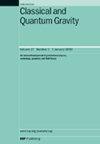Characterisation of circular light rays in a plasma
IF 3.7
3区 物理与天体物理
Q2 ASTRONOMY & ASTROPHYSICS
引用次数: 0
Abstract
It is the purpose of this paper to give a characterisation of circular light rays in a plasma on an axially symmetric and stationary spacetime. We restrict to the case of an unmagnetised, pressure-free electron–ion plasma and we assume that the plasma shares the symmetry of the spacetime. As a main tool we use two potentials, one for prograde and one for retrograde light rays, whose critical points are exactly the circular light rays in the plasma. In the case that the plasma density vanishes, the corresponding equipotential surfaces reduce to the relativistic Von Zeipel cylinders which have been discussed in many papers since the 1970s. In a plasma, the gradients of the potentials give the centrifugal and the Coriolis forces experienced by a light ray, where the plasma has an influence only on the centrifugal force. The introduction of these potentials allows us to generalise topological methods that have been successfully used for proving the existence or non-existence of circular vacuum light rays to the plasma case. The general results are illustrated with examples on Minkowski, Schwarzschild, Kerr and NUT spacetimes.等离子体中圆形光线的特性
本文的目的是在轴对称的固定时空中给出等离子体中圆形光线的特性。我们将其限制在非磁化、无压力的电子-离子等离子体的情况下,并假设等离子体具有时空对称性。作为一个主要工具,我们使用两个势,一个是前进的,一个是逆行的光线,其临界点恰好是等离子体中的圆形光线。在等离子体密度消失的情况下,相应的等势面减少到自20世纪70年代以来在许多论文中讨论过的相对论性冯·齐佩尔圆柱体。在等离子体中,电势的梯度给出了离心力和科里奥利力,其中等离子体只对离心力有影响。这些势的引入使我们能够将已成功用于证明圆形真空光线存在或不存在的拓扑方法推广到等离子体情况。用Minkowski, Schwarzschild, Kerr和NUT时空的例子说明了一般结果。
本文章由计算机程序翻译,如有差异,请以英文原文为准。
求助全文
约1分钟内获得全文
求助全文
来源期刊

Classical and Quantum Gravity
物理-天文与天体物理
CiteScore
7.00
自引率
8.60%
发文量
301
审稿时长
2-4 weeks
期刊介绍:
Classical and Quantum Gravity is an established journal for physicists, mathematicians and cosmologists in the fields of gravitation and the theory of spacetime. The journal is now the acknowledged world leader in classical relativity and all areas of quantum gravity.
 求助内容:
求助内容: 应助结果提醒方式:
应助结果提醒方式:


